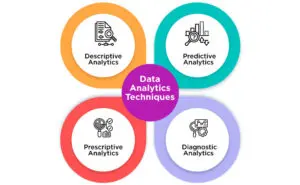Data analytics is the conversion of raw or unprocessed data into useful insights using the array of tools and technologies, or in other words, examining, cleaning, transforming, and interpreting data to draw conclusions, make predictions, prompt informed decision making, and discover meaningful patterns and trends.
In this blog, we will check out data analytics, its uses, techniques involved and the future.
In the current business scenario, having an ambitious edge over the competitors is essential, given the challenges like rapidly changing markets, unpredictable economies, and an unsteady political climate. For the organizations attempting to succeed in these demanding working conditions, data analytics is essential to embrace. This process often involves statistical tools, algorithms, and visualization techniques to make data understandable and actionable.
Key Features of Data Analytics
Generation of insights: Aids in revealing hidden patterns and trends.
Decision-Making: Supports data-driven strategies.
Optimization: Improves processes and efficiency.
From predicting consumer behavior to streamlining supply chains, data analytics has revolutionized how industries function.
Uses of Data Analytics
The applications of data analytics span across various industries, proving its versatility and importance.
- Business Intelligence
Companies use data analytics to monitor performance metrics, understand market trends, and predict future outcomes.
- Healthcare
In healthcare, data analytics is critical for diagnosing diseases, predicting outbreaks, and personalizing treatments.
- Marketing and Customer Insights
Marketers may comprehend consumer preferences and habits by using data analytics. This helps in designing personalized campaigns and improving customer experiences.
- Finance
The finance sector leverages data analytics for fraud detection, credit risk assessment, and portfolio management, ensuring secure and efficient operations.
- Education
In education, analytics helps track student performance, improve teaching methods, and design better curriculums.
These examples portray how data analytics empowers organizations to adapt, innovate, and excel in their respective fields.
Techniques in Data Analytics
- Descriptive Analytics
This technique focuses on summarizing past data. It answers questions like, “What happened?” by analyzing trends and patterns.
- Predictive Analytics
Machine learning and statistical models are used in predictive analytics to make future projections.
For example, it predicts customer churn or sales trends.
- Prescriptive Analytics
Prescriptive analytics suggests concrete actions in addition to forecasts. It answers, “What should we do?”
- Diagnostic Analytics
This technique digs deeper into data to understand the causes of past outcomes. It helps answer, “Why did this happen?”
Each technique serves a unique purpose and is chosen based on the specific problem or goal.
Why Analytics Matters
Organizations today are operating in a data-rich environment. People who don’t use data well run the risk of falling behind. Here’s why data analytics is indispensable:
Well-Informed Decision-Making: Analytics provides evidence-based insights in place of conjecture.
Efficiency Gains: Processes are streamlined, saving time and resources.
Competitive Edge: Businesses that understand their data can outpace competitors.
Improved Customer Experiences: Personalization and targeted strategies enhance customer satisfaction.
Furthermore, there is an increasing need for qualified data analysts due to the exponential growth of data. This makes data analytics not just a tool for businesses but also a lucrative career path.
Challenges in Analytics
While the benefits are immense, data analytics does come with challenges-
Data Quality: Unreliable insights are the result of poor data quality.
Privacy Concerns: Handling sensitive information requires strict adherence to data protection laws.
Complexity: Advanced analytics techniques can be challenging to implement without the right expertise.
Addressing these challenges requires investment in technology, training, and ethical practices.
Future of Data Analytics
The future of data analytics is exciting, with advancements in artificial intelligence (AI) and machine learning leading the way. Predictive and prescriptive analytics are becoming more accurate, while real-time data processing enables immediate insights. As the Internet of Things (IoT) continues to expand, data analytics will play a critical role in connecting devices and making smarter systems.
Conclusion
Data analytics is an evolutionary tool that is influencing the future, not just a chic term. Businesses and individuals can make wise decisions, spur growth, and open new opportunities by utilizing its strategies. As technology evolves, the potential of data analytics will only grow, solidifying its role as a cornerstone of modern innovation.
Read More:


